
3 minute read
Math
Students, like all mathematicians, learn how to articulate their problem-solving strategies with their class. This expands the thinking each student is exposed to as a variety of strategies are presented, and it gives teachers insight as to how the child understands mathematical concepts.
Mathematical practices are incorporated into the various units and echo the 20 Habits Mustard Seed Students Should Develop: • Make sense of problems and persevere in solving them. • Construct viable arguments and critique the reasoning of others. • Model with mathematics. • Use appropriate tools strategically. • Attend to precision. • Look for and make use of structure. • Look for and express regularity in repeated reasoning.
Advertisement
Mustard Seed School follows the Technical Education Research Centers (TERC) Investigations curriculum for mathematics. Math skills begin with classifying and counting tasks. Graphs and measurement skills enter the classroom as students need to communicate and understand quantity. Composing and decomposing numbers in different ways develops the concepts of addition and subtraction in a dynamic study. Students use manipulatives, games, and movement as they develop proficiencies.
FIRST GRADE
Operations and Algebraic Thinking • Represent and solve problems involving addition and subtraction • Understand and apply properties of operations and the relationship between addition and subtraction • Add and subtract within 20 • Work with addition and subtraction equations
Number and Operations in Base Ten • Extend the counting sequence • Understand place value
• Use place value properties of operations to add and subtract
Measurement and Data • Measure lengths indirectly and by iterating length units • Tell and write time • Represent and interpret data
Geometry • Reason with shapes and their attributes
SECOND GRADE
Operations and Algebraic Thinking • Represent and solve problems involving addition and subtraction • Add and subtract within 20 • Work with equal groups of objects to gain foundations for multiplication
Number and Operations in Base Ten • Understand place value • Use place value properties of operations to add and subtract
Measurement and Data • Measure and estimate lengths in standard units • Relate addition and subtraction to length • Work with time and money • Represent and interpret data
Geometry • Reason with shapes and their attributes
THIRD GRADE
Operations and Algebraic Thinking • Represent and solve problems involving multiplication and division • Understand properties of multiplication and the relationship between multiplication and division • Multiply and divide within 100 • Solve problems involving the four operations, and identify and explain patterns in arithmetic
Number and Operations in Base Ten • Use place value properties of operations to perform multi-digit arithmetic • Develop understanding of fractions as numbers
Measurement and Data • Solve problems involving measurement and estimation • Represent and interpret data • Geometric measurement: understand concepts of area and relate area to multiplication and to addition. • Geometric measurement: recognize perimeter.
Geometry • Reason with shapes and their attributes.

Students do more than rote calculations. They learn different strategies to analyze a problem, develop number sense which is the ability to mentally represent numbers, and practice flexibility in applying multiple solutions to a problem.

Blocks
Children learn best through play and experimentation. Blocks provide an especially rich and effective tool for both of these areas. Our classrooms protect space and time for regular block play. Blocks is an area where creativity and visual arts intersect with problem-solving, math, and science. Not to mention the social learning that happens as imaginative play and collaboration occur. Blocks play is complex and challenging. Blocks are taught carefully at Mustard Seed School so that children can grow in sophistication in their ability to use blocks effectively as a tool for learning and expression.
Some notable first-grade projects in blocks include: • Recreating a Viking ship. Students grapple with how to use rectangular blocks to make a curved ship. • Measuring the dimensions of block structures during the 3D geometry study. How many inches high, wide, and long is each structure? • Building a city containing transportation systems, considering how much space must be allocated for various modes of transportation in a block city. • Incorporating natural objects into block structures to demonstrate knowledge of bird nests and habitats.






